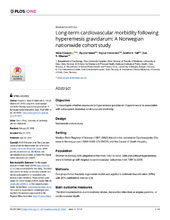Long-term cardiovascular morbidity following hyperemesis gravidarum: A Norwegian nationwide cohort study
Peer reviewed, Journal article
Published version

Åpne
Permanent lenke
https://hdl.handle.net/1956/21261Utgivelsesdato
2019-06-12Metadata
Vis full innførselSamlinger
Originalversjon
https://doi.org/10.1371/journal.pone.0218051Sammendrag
Objective: To investigate whether exposure to hyperemesis gravidarum (hyperemesis) is associated with subsequent maternal cardiovascular morbidity. Design: Nationwide cohort study. Setting: Medical Birth Registry of Norway (1967–2002) linked to the nationwide Cardiovascular Disease in Norway project 1994–2009 (CVDNOR) and the Cause of Death Registry. Population: Women in Norway with singleton births from 1967 to 2002, with and without hyperemesis, were followed up with respect to cardiovascular outcomes from 1994 to 2009. Methods: Cox proportional hazards regression model was applied to estimate hazard ratios (HRs) with 95% confidence interval (CI). Main outcome measures The first hospitalisation due to nonfatal stroke, myocardial infarction or angina pectoris, or cardiovascular death. Results: Among 989 473 women with singleton births, 13 212 (1.3%) suffered from hyperemesis. During follow-up, a total of 43 482 (4.4%) women experienced a cardiovascular event. No association was found between hyperemesis and the risk of a fatal or nonfatal cardiovascular event (adjusted HR 1.08; 95% CI 0.99–1.18). Women with hyperemesis had higher risk of hospitalisation due to angina pectoris (adjusted HR 1.28; 95% CI 1.15–1.44). The risk of cardiovascular death was lower among hyperemetic women in age-adjusted analysis (HR 0.73; 95% CI 0.59–0.91), but the association was no longer significant when adjusting for possible confounders. Conclusion: Women with a history of hyperemesis did not have increased risk of a cardiovascular event (nonfatal myocardial infarction or stroke, angina pectoris or cardiovascular death) compared to women without.
